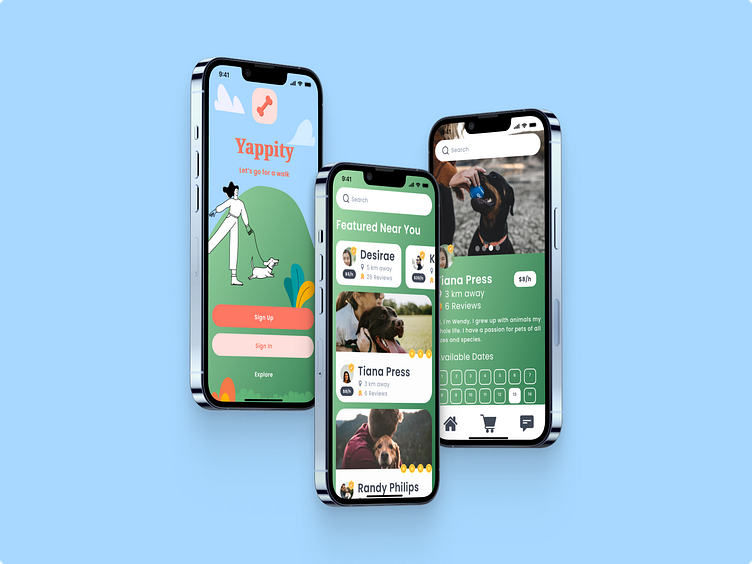Yapitty - Dog Walking App
As part of the Dribbble Product Design Course, we were tasked with creating a dog walking app. We had to move through all stages of the design process with weekly videos and mentorship sessions to help guide us, but in the end, the final product was one we took from the problem statement through to prototyping and handover.
The Brief
The challenge was simple...
Dog owners sometimes need help caring for and walking their dogs. Create a service to connect dog owners with dog walkers. Consider how we can help dog owners trust their dogs are in safe hands.
We had the move through the full product design cycle.
Research & Empathise
Define the Requirements
Ideate
Prototype
Test
Refine & Deliver
Problem Statement
We started by brainstorming the problem we had to solve, our goals and the three groups the app had to cater for; the dog owner, the dog walker, and the fictitious client whose business this was.
The first issue that arose, even at this early stage, before we got to User Research, was trust.
The owner needed to trust the dog walker with their pet and that they would need to let them into their homes.
The business needed to trust the walker and vet them in some way to build trust with the dog owner.
And finally, the walker needed to trust the business as this was their income stream.
As you can see from the stickies above, a slew of other issues, risks and rewards also surfaced. But the purpose of this case study is we'll keep it simple.
An app that connects dog owners to trustworthy dog walkers, provides complete transparency as to what's happing during a walk for the owner, and that makes money for both the client and the dog walker.
User Research
Next, we moved into the user research phase. Most of the research here was qualitative. We interview several dog owners as well as a full-time dog walker.
As we suspected trust was a major issue for dog owners.
As we suspected, trust was a significant issue for dog owners, but they also wanted services like training, rehab, excursions, grooming and pet and home sitting.
Owners also wanted the process to be cashless with walkers that have had background checks for verified walkers.
The dog walker we interviewed suggested live tracking, a physical tracker on the dog. A panic button in the app, treats and food trackers, an emergency map of the closest vets and the ability to share safe dog walking routes.
Market Research
Market research was mostly quantitative. In the South African market there are currently no dog walking apps, but we looked at international competitors like Wag, Rover, Barkley and Fetch.
While there are no local dog-walking competitors, the market does seem to have potential if one looks at the numbers above.
Competitor apps overseas left very little out in terms of possible features but did offer an easy roadmap of the features that one could implement while not just cloning an app.
Client Persona
Next we moved to mapping out personas for the app's users, a dog owner, dog walker and even a dog itself.
User Flow
With our brief, research and persona in hand, we started mapping out the flow of the app.
The most important features we would need as driven by the brief, our research and our three personas allowed us to refine the flow to something we felt was fast enough to onboard a user, and book a walk, while not leaving anything to chance or the user feeling lost.
Wireframes
The final iteration of the user flow left us with enough information to move on to wire framing the app.
In the end, we went through 2 rounds of wireframing with different interactions of the essential screens; in the end, we selected the best of the two rounds and combined some of the elements from screens in both rounds to reach our final wireframes for the user flow.
Visual Designs
We then jumped on to creating some very rough full-fidelity designs used on the wireframes. These were then refined and the designs standardised with auto layouts to make them more flexible while following the ruleset we created and utilising components as far as possible so that future changes and updates to the design system would be simple and fast.
Prototype
Finally, we prototyped the main flow of a dog owner signing up for the app and booking a walk for our fictitious client and user testing.
We ended up adding in additional screens and signifying some steps and elements, and in some cases adding more guidance based on the testing we conducted.
Personal Takeaways
The process was quite fun, and while one might not follow each step to the letter in real life, where there are many constraints on time and budget, it was a great learning experience in terms of the process to follow, the tools to use and the idea of trying to refine and innovate as much as possible within the constraints one would experience in an actual project.











